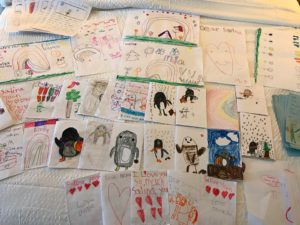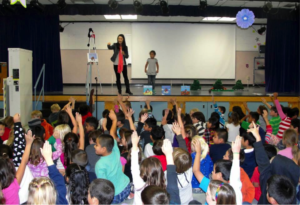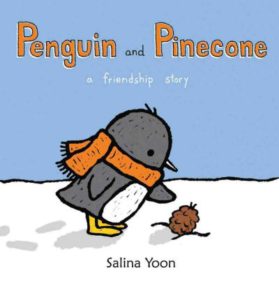A love of reading is one of the most important things anyone can foster in a child. Reading helps with analytical thinking, creation and builds confidence and empathy. That’s why we’re so excited for this guest post by our wonderful client, author/illustrator Salina Yoon, on how student empowerment can create a life-long love of literature. Here’s Salina…

Teaching the mechanics of how to read is a great first step but by encouraging a love of reading, you give children something even more special – a way to learn and explore while having fun. Here are 10 ways to nurture a culture of reading through literary exposure, encouragement, group and solo activities, special events, and empowering students with choice.
1. Read Aloud
How you read is as important as what you read. Be dramatic, theatrical, and expressive. Engage your audience with hand motions, sounds, props, puppets, and even costumes or accessories whenever possible. Students can participate by reading the dialogue parts in character. And like a performance, end the session with a big round of applause, or jazz hands (for a silent applause).
2. Create Fun Reading Spaces
Do you like reading your favorite book sitting at a desk? Probably not, and kids don’t either! Not all kids are alike, so create various spaces for readers to pick what’s appealing to them. You can create a reading spot with a small rug and cushions on the floor, or pop up a mini tent with a lamp or flashlight inside. Offer various seating options, such as cushioned arm chairs, bean bags, or bungee chairs. How to get these items? A call to parents to donate some items might do the trick, or hold a Read-a-thon Fundraiser.

3. Book Review Bulletin Board
Create a book review bulletin board so students can recommend books to each other. Giving them a place to share information about their favorite books is a great way to encourage others within the group to read.
- Step 1: Paste the book cover image (or it can be drawn).
- Step 2: Write the title, author, and illustrator of the book.
- Step 3: Write a few lines about the book and why they liked it.
- Step 4: Have them sign their name as the reviewer.
- Step 5: Just for fun, offer up emoji cut-outs to include in their review. Was their book heartwarming, scary, funny, sad, happy, or clever?
This activity allows readers’ opinions to be heard and valued!
4. Class Literary Pumpkin
Not all literary activities have to include reading or writing. Celebrate Halloween by decorating a class pumpkin based on a literary character. Present and display these pumpkins along with a copy of the book for the whole school to see. This is a fun and creative way to celebrate books. Check out the fun book-themed pumpkins on Mrs. Houlin’s eSchool blog.
5. Author Studies
Doing an author study is a great way to share multiple books by the same author. Discover new and current authors, and follow them online. Social media allows for classrooms to engage with authors directly. I love it when I’m tagged on posts by teachers and librarians, especially when they post about a book activity. You can follow me on Twitter at @salinayoon and it’s easy to find other authors there too. BookPage is a great resource for finding author Q&As to do a study. Click here for my page. To find other authors, do a search on www.bookpage.com.

6. Organize an Author Visit
Author visits generate excitement and buzz around books and reading for the entire school. As a visiting author, I’ve experienced many powerful moments that could have only happened by being there, face to face with a child. I often share my story as a young person who emigrated from South Korea, and having struggled with reading and writing. This resonates for so many children who struggle, too, for various reasons, and I give them hope. I show them by example how any challenge can be overcome by sheer dedication fueled by passion! Every author will bring their own personal story to share, and if a connection is made with a child in the audience, it can be life-transforming. Click for 10 tips for amazing author visits, and here for 21 ways to fund an author visit.
7. Mock Caldecott and Newbery
The Caldecott and Newbery Awards are two of the most distinguished children’s book awards given each year by the American Library Association. The judges are a select committee of librarians, but for the Mock Caldecott and Newbery, your students can be the judges! This is a good opportunity for teachers to discuss what makes an illustration or a story compelling. It’s also a great way to let your students know that their opinions matter. Click here for help with hosting your own mock Caldecott.
8. Write a Book
Encourage students to write and illustrate their own book. Have them use a favorite book as a mentor text, or give them a story prompt. Example: Students can read PENGUIN AND PINECONE. What if Penguin found something else besides a pinecone? What would he find, and how would it change his life? Reading will inspire writing, and writing will inspire more reading. Display your students’ books at Open House or another school event so the books can be shared.
 9. Organize a Book Club
9. Organize a Book Club
Not all kids like the crowds at lunchtime and having the pressure of needing to sit with someone so they don’t appear to be friendless. I speak from experience! It was hard in elementary school when I wasn’t good at making friends and felt awkward sitting alone. Why not have the library or a classroom open for students who want to sit and read (while eating lunch?) in a safe, judgment-free environment? Their love of books (and for quiet) might bring these kids together as friends, too.
10. Reward with Reading Time
If students get done with their work early, give them the time to read. By presenting reading time as a treat, you reinforce that it’s a fun activity. Encourage them to find a good book outside of their required reading list. Promote and foster reading for fun!
Salina Yoon is the author and illustrator of more than 160 books for children. Her most recent award was the 2018 Geisel Honor for MY KITE IS STUCK AND OTHER STORIES (A Duck Duck Porcupine! Book).
Learn more about Salina Yoon and her school visits on her speaker page.
